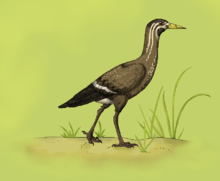Lithornithidae
| Lithornithidae | |
|---|---|
 | |
| Pseudocrypturus cercanaxius fossil cast, Zoologisk Museum, Copenhagen | |
| Scientific classification | |
| Kingdom: | Animalia |
| Phylum: | Chordata |
| Class: | Aves |
| Order: | †Lithornithiformes |
| Family: | †Lithornithidae Houde, 1988 |
| Genera | |
|
Calciavis | |
Lithornithidae is an extinct, possibly paraphyletic[1] (but see below) clade of early paleognath birds. They are known from fossils dating to the Upper Paleocene through the Middle Eocene of North America and Europe, with possible Late Cretaceous representatives.[1][2] All are extinct today;[3] the youngest specimen is the currently unnamed SGPIMH MEV1 specimen from the mid-Eocene Messel Pit site.[4]

Lithornithids had long, slender, bills for probing. They closely resembled modern tinamous. They possessed a rhynchokinetic skull with relatively unfused cranial bones, a weakly fused pygostyle and a splenial. The unguals were more curved than in tinamous and probably allowed better perching in trees.
The order Lithornithiformes was erected by Dr. Peter Houde in 1988. Initially, only three genera (Lithornis, Paracathartes, and Pseudocrypturus) and eight named species were included.[3] Promusophaga (Harrison & Walker, 1977) originally considered a stem-turaco, is considered synonymous with Lithornis vulturinus. Fissuravis may also belong to the clade,[5] and several unnamed remains are known.
Taxonomy
Lithornithiformes Houde, 1988[6][7]
- †Lithornithidae Houde, 1988 (False tinamous)
- †Calciavis grandei Nesbitt, 2016
- †Fissuravis weigelti Mayr, 2007
- †Paracathartes howardae Harrison, 1979 (Early Eocene of WC US)
- †Pseudocrypturus cercanaxius Houde, 1988
- †Lithornis Owen, 1840 [Promusophaga Harrison & Walker, 1977; Pediorallus Harrison, 1984; Parvigyps Harrison & Walke,r 1977] (Paleocene – Early Eocene)
- †L. celetius Houde, 1988
- †L. plebius Houde, 1988
- †L. promiscuous Houde, 1988
- †L. nasi (Harrison, 1984) Houde, 1988 [Pediorallus nasi Harrison, 1984]
- †L. hookeri (Harrison, 1984) Houde, 1988 [Pediorallus hookeri Harrison, 1984]
- †L. vulturinus Owen, 1840 [Parvigyps praecox Harrison & Walker, 1977; Promusophaga magnifica Harrison & Walker, 1977; Pediorallus barbarae Harrison & Walker, 1977a] (London Clay Early Eocene of England)
Several studies have shown conflicting status on the monophyly of the group. Some studies recover them as a paraphyletic assemblage leading to modern paleognaths,[1] but more recent examinations group them in a single, natural group basal to the rest of Palaeognathae.[8] Of issue is Paracathartes, which differs radically from other lithornithids and has been suggested to more closely related to extant paleognaths,[9] though it is recently recovered as a derived lithornithid.[10][note 1]
Lithornis itself may be paraphyletic in relation to Paracathartes and Pseudocrypturus.[10]
Flight

Unlike modern paleognaths, lithornithids were generally decent flyers. Lithornis, Pseudocrypturus and Fissuravis all possess well developed keels, pectoral girdle elements and proportionally large wings, allowing for soaring flight akin to that of birds such as modern vultures and storks.[9][11][1] By contrast, however, Paracathartes had shorter and more robust wing elements and a deeper keel, relating to a flight style more akin to that of modern gamefowl and tinamous, and was possibly far more terrestrial.[1]
Unlike neognath birds, lithornithids had small pygostyles, and probably no tails.[1] This may not have impaired their flight, however, since prehistoric birds like enantiornithes also generally had no tails.
It has been suggested that lithornithids have increased in size in response to the extinction of terrestrial pterosaurs, suggesting that they occupied similar ecological niches.[12]
Eggs
Several egg fossils have been attributed to lithornithid birds.[1] Both Lithornis and Paracathartes have entire nests assigned to them.[13] Their eggshells are, perhaps unsurprisingly, noted as being "ratite-like".[14]
Notes
- ↑ This particular study defaults to the traditional paleognath classification scheme, based on the similarities with tinamous. The more recent genetic revaluations are vindicated, however, in that it recognises that the features uniting lithornithids to tinamous in the study are most likely basal to paleognaths as a whole.
References
- 1 2 3 4 5 6 7 Paleogene Fossil Birds
- ↑ A lithornithid (Aves: Palaeognathae) from the Paleocene (Tiffanian) of southern California
- 1 2 Houde, Peter W. (1988). "Paleognathous Birds from the Early Tertiary of the Northern Hemisphere". Publications of the Nuttall Ornithological Club. Cambridge Massachusetts, USA: Nuttall Ornithological Club. 22.
- ↑ First substantial Middle Eocene record of the Lithornithidae (Aves): A postcranial skeleton from Messel (Germany)
- ↑ Gerald Mayr, Paleogene Fossil Birds
- ↑ Mikko's Phylogeny Archive Haaramo, Mikko (2007). "Paleognathia - paleognathous modern birds". Retrieved 30 December 2015.
- ↑ "Taxonomic lists- Aves". Paleofile.com. Archived from the original on 11 January 2016. Retrieved 30 December 2015.
- ↑ Nesbitt, Sterling J.; Clarke, Julia A., The anatomy and taxonomy of the exquisitely preserved Green River Formation (early Eocene) lithornithids (Aves) and the relationships of Lithornithidae. (Bulletin of the American Museum of Natural History, no. 406), 2016-06-30
- 1 2 Houde, Peter W. (1988). "Paleognathous Birds from the Early Tertiary of the Northern Hemisphere". Publications of the Nuttall Ornithological Club (Cambridge, MA)
- 1 2 Worthy, T., Mitri, M., Handley, W., Lee, M., Anderson, A., Sand, C. 2016. Osteology supports a steam-galliform affinity for the giant extinct flightless birds Sylviornis neocaledoniae (Sylviornithidae, Galloanseres). PLOS ONE. doi: 10.1371/journal.pone.0150871
- ↑ Gerald Mayr, The Birds from the Paleocene Fissure Filling of Walbeck (Germany), Journal of Vertebrate Paleontology 27(2):394–408, June 2007
- ↑ Longrich, N.R., Martill, D.M., and Andres, B. (2018). Late Maastrichtian pterosaurs from North Africa and mass extinction of Pterosauria at the Cretaceous-Paleogene boundary. PLoS Biology, 16(3): e2001663. doi:10.1371/journal.pbio.2001663
- ↑ Houde, Peter W. (1988). "Paleognathous Birds from the Early Tertiary of the Northern Hemisphere". Publications of the Nuttall Ornithological Club (Cambridge, MA) 22.
- ↑ Gerald Grellet-Tinner and Gareth J. Dyke, The eggshell of the Eocene bird Lithornis, Acta Palaeontologica Polonica 50 (4), 2005: 831-835